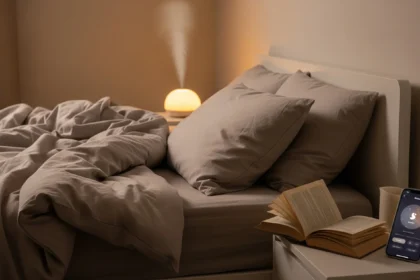For many pet owners, the idea of Co-Sleeping with Furry Friends is an irresistible comfort. There’s something undeniably heartwarming about your beloved dog curled at your feet or your cat purring softly on your chest as you drift off to sleep. It feels natural, intimate, and a testament to the deep bond we share with our animal companions. Yet, beneath this idyllic image often lies a less romantic reality: restless paws, nocturnal purrs, sudden shifts, and early morning demands that can profoundly disrupt human sleep, leaving us feeling less refreshed and more irritable. While the emotional benefits of sharing a bed with a pet are clear, the scientific evidence suggests that this cherished habit might come at a cost to our precious rest, prompting a need for strategies that allow for both comfort and quality sleep.
Consider Sarah, a devoted cat mom who adored her feline companion, Luna. Luna insisted on sleeping on Sarah’s pillow, often purring loudly, kneading Sarah’s hair, or batting at her face in the wee hours. Sarah loved Luna dearly, but she woke up every morning with a stiff neck and dark circles under her eyes, feeling perpetually exhausted. Or think of David, whose large Labrador, Buddy, claimed half the bed, often snoring, twitching, and hogging the covers. David cherished Buddy’s companionship but found himself relegated to the edge of the mattress, waking frequently as Buddy shifted. These scenarios are common, highlighting the delicate balance between the joy of pet companionship and the physiological imperative of uninterrupted sleep.
The Allure of the Shared Bed: Why We Do It
The desire to share our sleeping space with pets is deeply rooted in our emotional connection to them. Pets offer:
- Comfort and Security: The presence of a pet can be incredibly soothing, reducing feelings of loneliness and anxiety. The rhythmic breathing or purring of a pet can act like a natural white noise machine, fostering a sense of calm.
- Companionship: For many, pets are family members, and sharing a bed reinforces that bond, providing a sense of closeness and affection.
- Warmth: On a cold night, a furry companion can provide welcome warmth.
- Reduced Stress: Studies have shown that interacting with pets can lower cortisol levels (the stress hormone) and increase oxytocin (the “love hormone”), benefits that can extend into the bedtime routine.
These positive emotional associations are powerful motivators, often outweighing the subtle, or not-so-subtle, sleep disruptions.
The Scientific Reality: When Comfort Meets Compromise
While the emotional benefits are undeniable, scientific research on co-sleeping with pets presents a more nuanced picture. For some, the presence of a pet is genuinely calming and doesn’t negatively impact sleep. However, for a significant portion of the population, especially those who are light sleepers or have specific sleep needs, pets can be a source of significant sleep fragmentation.
Sleep Fragmentation: The Hidden Cost
The primary concern with co-sleeping with pets is sleep fragmentation. This refers to frequent, brief awakenings during the night that you might not even remember. While you might feel like you slept through the night, these micro-arousals prevent your brain from cycling effectively through the crucial stages of sleep:
- NREM (Non-Rapid Eye Movement) Sleep: Particularly deep N3 (slow-wave sleep), which is vital for physical restoration, hormone regulation, and memory consolidation.
- REM (Rapid Eye Movement) Sleep: Crucial for emotional processing, problem-solving, and creative thinking.
When sleep is constantly interrupted, even for a few seconds, you spend less time in these restorative stages, leading to “sleep debt.” You might wake up feeling as if you haven’t slept at all, leading to daytime fatigue, impaired cognitive function, irritability, and a weakened immune system.
A study published in the Mayo Clinic Proceedings in 2017 investigated the sleep patterns of individuals who shared their beds with dogs. Using polysomnography (sleep studies), researchers found that while sleeping with a dog in the same room did not negatively impact sleep, sleeping with a dog in the bed was associated with reduced sleep efficiency, meaning participants spent less time actually sleeping relative to the time they were in bed. The study suggested that the movements of the dog, even subtle ones, could be enough to cause micro-arousals in the human sleeper.
Common Pet-Related Sleep Disruptions:
- Movement: Pets shift positions, stretch, scratch, or twitch, especially during their own sleep cycles (which differ from humans). A large dog can take up significant bed space, forcing the human into uncomfortable positions.
- Noise: Snoring (common in brachycephalic breeds like bulldogs), purring, scratching, whimpering, or sudden barks can all disrupt sleep.
- Temperature: Pets radiate heat, which can make the bed too warm for human comfort, especially for “hot sleepers.”
- Schedule Differences: Pets, particularly dogs, often have different sleep-wake cycles than humans. They might need to go outside in the middle of the night or wake up very early, prompting their human companions to stir.
- Allergies and Asthma: For individuals with pet allergies or asthma, having pets in the bedroom, especially in the bed, can trigger symptoms that severely impair breathing and sleep quality. Dander, saliva, and urine can accumulate in bedding, creating a constant irritant.
- Dominance or Territorial Behavior: In some cases, a pet might exhibit territorial behavior, growling or becoming agitated if a partner moves too close, further disrupting sleep and potentially creating tension.
Bridging the Gap: Tips for Peaceful Co-Sleeping
The goal isn’t necessarily to banish your beloved pet from the bedroom entirely, but to find a harmonious balance that prioritizes both your bond and your sleep health. Here are scientifically informed strategies to bridge the gap:
1. Establish a Designated Pet Sleeping Area (Not in Your Bed)
If your sleep is consistently disrupted, the most effective solution is often to transition your pet to their own comfortable sleeping space near your bed, or even in the same room but not in the bed.
- Comfortable Pet Bed: Invest in a high-quality, comfortable pet bed that is exclusively theirs. Place it close to your bed initially, perhaps within arm’s reach, to maintain a sense of closeness.
- Positive Reinforcement: Make their bed a positive place. Use treats, praise, and their favorite toys to encourage them to use it.
- Gradual Transition: Don’t just suddenly banish them. Gradually move their bed further from yours over several nights if needed, or start with them on their bed for part of the night and allow them into your bed only in the very early morning if that’s a compromise you can make.
2. Maintain Consistent Pet Schedules
Just as humans benefit from a consistent sleep-wake schedule, so do pets.
- Consistent Feeding and Potty Breaks: Feed your pet at consistent times and ensure they have their last potty break right before your bedtime. This reduces the likelihood of them waking you up for bathroom needs in the middle of the night.
- Daytime Activity: Ensure your pet gets adequate exercise and mental stimulation during the day. A tired pet is a sleeping pet. A long walk or a vigorous play session before bed can significantly improve their nighttime rest, and yours.
3. Address Pet Health Issues
Many pet-related sleep disruptions stem from underlying health issues in the pet.
- Snoring: If your pet snores loudly, especially if it’s accompanied by gasping or pauses in breathing, consult your veterinarian. Just like in humans, pet snoring can be a sign of sleep apnea or other respiratory issues that require medical attention.
- Restlessness: Excessive twitching, pacing, or restlessness during sleep could indicate pain, anxiety, or other medical conditions. A vet can rule out underlying health problems.
- Allergies: If you suspect pet allergies are impacting your sleep, consult a doctor for diagnosis and treatment. Strategies might include air purifiers, frequent washing of pet bedding, and keeping pets out of the bedroom.
4. Optimize Your Own Sleep Environment
Even with a pet, your bedroom should still be optimized for human sleep.
- Temperature Control: Ensure your room is cool (around 60-67°F or 15-19°C). If your pet adds too much warmth, this reinforces the need for separate sleeping spaces.
- Cleanliness: Regularly wash pet bedding and your own linens to minimize dander, dust, and allergens.
- Sound Masking: If your pet makes occasional noises, a white noise machine or earplugs can help mask these sounds.
5. Consider a “Pet-Free” Zone
For some, the only truly effective solution is a “pet-free” bedroom. This doesn’t mean you love your pet any less; it means you prioritize your health and well-being, which ultimately allows you to be a better, more patient, and more energetic pet owner during waking hours.
- Gradual Implementation: Introduce this change gradually. Start by having the pet sleep just outside the bedroom door, then perhaps in a crate or bed further away.
- Maintain Daytime Affection: Ensure you compensate for the lack of nighttime cuddles with extra playtime, attention, and affection during the day. Your pet thrives on your presence, not necessarily your bed.
The Unseen Benefits of Restful Sleep for Pet Owners
When a pet owner successfully bridges the sleep gap, the benefits extend beyond just feeling less tired. A well-rested individual is:
- More Patient: Less likely to snap at their pet or become frustrated by normal pet behaviors.
- More Engaged: Has more energy for playtime, walks, and training, strengthening the human-animal bond.
- Healthier: Reduced risk of chronic diseases linked to sleep deprivation, allowing for more years of active companionship with their pet.
- Safer: Reduced risk of accidents due to fatigue.
Conclusion: A Win-Win for Humans and Their Furry Friends
The decision to share your bed with a pet is a deeply personal one, often driven by love and a desire for closeness. However, ignoring the potential impact on your sleep can lead to a silent erosion of your health and well-being. The science is clear: while pets offer immense emotional benefits, their presence in the bed can, for many, lead to fragmented and less restorative sleep.
By understanding the dynamics of sleep, recognizing the signs of disruption, and implementing thoughtful strategies, pet owners can achieve a harmonious balance. Whether it’s creating a comfortable pet bed nearby, establishing consistent routines, addressing pet health issues, or, if necessary, creating a pet-free sleeping zone, the goal is the same: to ensure both humans and their beloved furry friends get the quality rest they need. Ultimately, a well-rested pet owner is a happier, healthier, and more engaged companion, capable of giving their furry friend the very best of themselves, both day and night.
Disclaimer: The information provided in this article is for general informational purposes only and does not constitute medical advice. It is not a substitute for professional medical advice, diagnosis, or treatment. Always seek the advice of your veterinarian for any questions you may have regarding your pet’s health or behavior, and consult your physician or other qualified health provider for any questions regarding your own medical condition. Never disregard professional medical advice or delay in seeking it because of something you have read on this website.













